Yokohama F. Marinos, Australia and the Old Firm Derby have all been involved in a strange love triangle in recent years.
Over the past decade, the club brought Japan and Celtic legend, Shunsuke Nakamura, back, appointing him as captain until he departed in 2017. A year later, the Australia men’s national team head coach Ange Postecoglou was placed in charge of the first team following Erick Mombaerts’ departure.
The Australian was highly successful with Marinos, helping the Japanese giants to their first J1 League title in 15 years in 2019 and actually the side’s first trophy since being victorious in the Emperor Cup final in 2013.
Following Postecoglou’s success in Japan, the coach was scouted by Celtic after a disastrous campaign in 2020/21 where the Bhoys lost the Scottish Premiership by 25 points to bitter rivals Rangers.
Postecoglou won the title in his debut season at Celtic Park, while Marinos managed to find an excellent replacement too for the 57-year-old in the form of another Australian manager.
This time, the Japanese outfit appointed the former Rangers defender Kevin Muscat as the new boss, who won three league titles with Melbourne Victory. Muscat had previously worked on Postecoglou’s Australia coaching staff for the 2017 Confederations Cup and so knew how to carry on his predecessor’s legacy in Yokohama. And carry it on he has.
Yokohama Marinos are top of the J1 League right now and with just five games remaining, Muscat’s men are five points clear. Unless a cataclysmic catastrophe occurs, they will be crowned champions once more in a few weeks’ time.
This tactical analysis piece will be a scout report of Yokohama F. Marinos. It will be an analysis of the tactics deployed by Muscat which have led the side to be champions-elect.
Formations and differences with 2019
The two managers have been quite similar with their approaches in soon-to-be both of Yokohama F. Marinos’ title victories over the past three years.
During his spell at the NISSAN Stadium, Postecoglou was rather unmalleable with his approach to the team’s base formation. Marinos primarily lined out in a 4-2-3-1 but this would only be taken into account during the defensive phases.
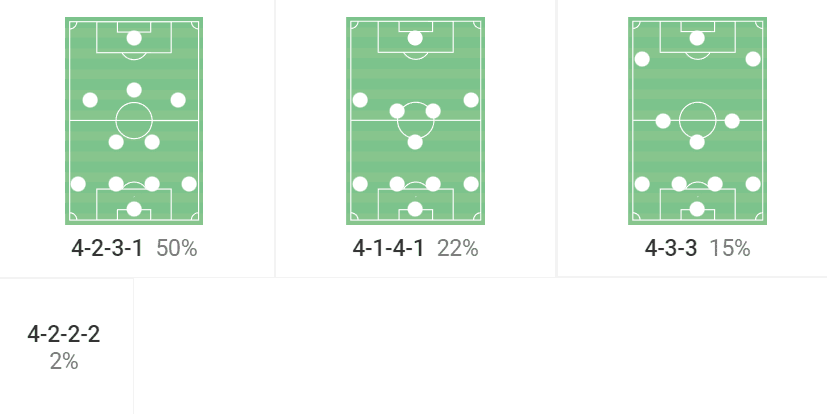
Overall, the 4-2-3-1 was used in 50 percent of the team’s games. The current Celtic manager did like to rotate this conventional shape with the more offensively balanced 4-3-3, including the 4-1-4-1, which the team set out in 37 percent of the time.
Muscat has been much less flexible than that. The team’s base formation only really becomes apparent out of possession, but the Australian has been adamant for his side to structure themselves in a 4-2-3-1, becoming a 4-4-2 at times as well once the number ‘10’ pushes up next to the centre-forward to create a two-man first line of pressure.
Unlike in 2019, the 4-2-3-1 has been used in 85 percent of Marinos’ games thus far while the 4-1-4-1 has seen just two percent usage.
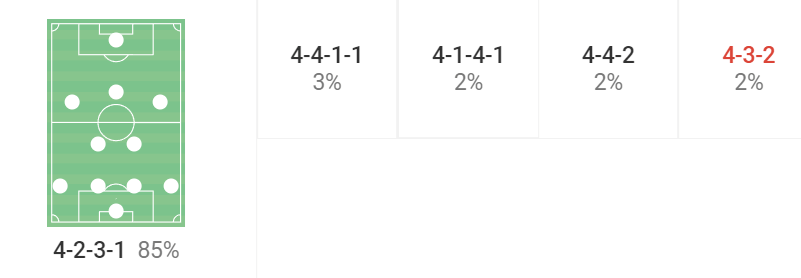
Nevertheless, irrespective of the base formation, Muscat has carried on Postecoglou’s legacy of playing some of the most scintillating and fluid possession-based football in the J1 League, or perhaps all of Asia.
Let’s take a look at why Yokohama F. Marinos are a joy to watch on the ball.
Build-up phase
Yokohama F. Marinos are a possession-heavy side. Muscat wants his players to control the game by having the ball, looking to provoke and open up space within the opposition’s defensive block while being patient and careful.
However, the J1 League leaders do so by pushing as many players in front of the ball as possible. This gives the team plenty of forward passing options between the lines and out wide in order to play through the opponent.
There is a plus one rule in football though which many sides abide by. Essentially, this means that the team in possession will always look to have an extra man in the first line depending on how many players the opposition press with. So, if the defending side use a front two to press, the attacking team keeps three behind the ball to have a 3v2 situation. Yokohama bow to this blueprint.
But, quite often, coaches will insist on one of the fullbacks tucking inside or else for a midfielder to drop in between or to the side of the centre-backs to create the plus one. Muscat pushes his goalkeeper forward instead as, again, he wants to have as many outfield players in advance positions as plausible.
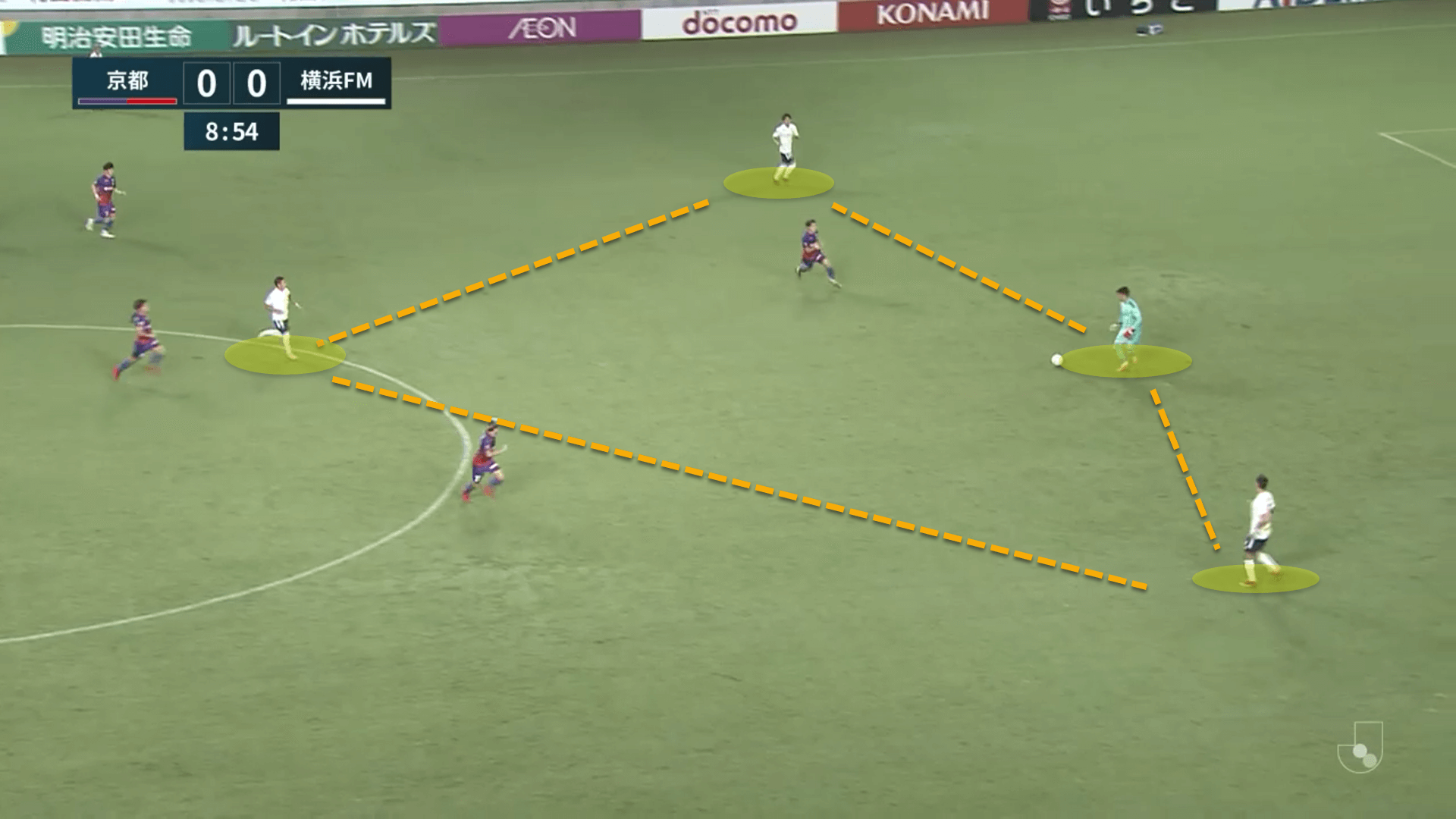
Here, the Yokohama-based club are being pressed by a two-man first line of pressure. The centre-backs have split wide to accommodate the high positioning of goalkeeper Yohei Takaoka.
Takaoka is excellent with the ball at his feet, giving Yokohama FM the ability to have him so high up the pitch, running the risk of the shot-stopper being pressed without giving the ball away. So far this season, the Japanese keeper boasts a 91.2 percent passing accuracy with a 98.5 percent accuracy on short passes.
High positioning by Takaoka is a constant for the J1 League side, particularly against teams that tend not to apply too much pressure in the final third. The 26-year-old’s heatmap displays this:
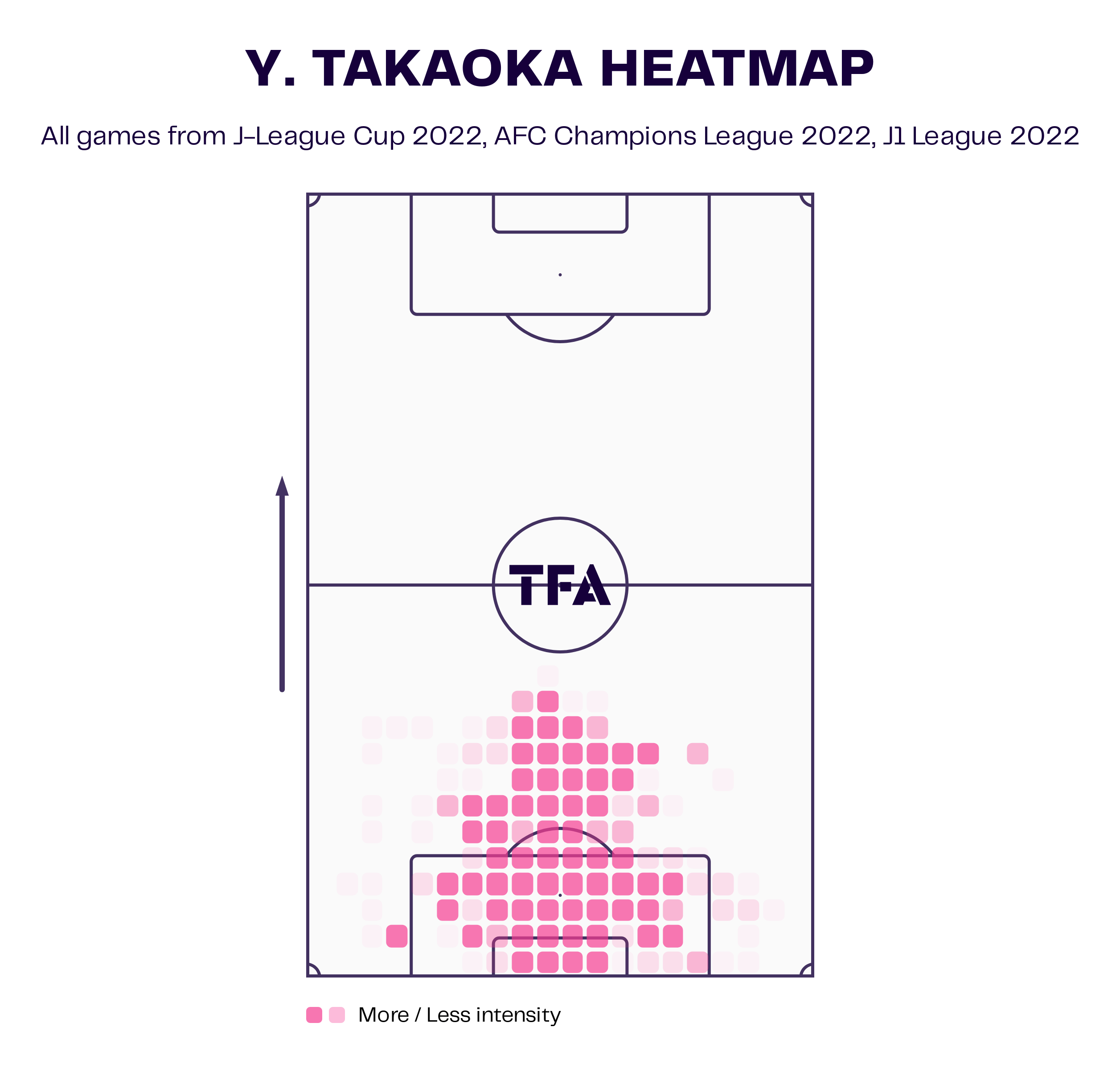
Muscat is a firm believer in having his side play through the central areas. There are times when the middle of the park is closed off by the opponent and so Yokohama FM must play wide to progress from the build-up phase, but for the most part, the players are encouraged to try to move the ball centrally to bypass the opposition’s press or break down their mid-block.
This requires plenty of movement from the players ahead of the ball, hence why Muscat wants as many forward options as possible. The double-pivot are particularly important during these progression moments. Not only must they move around to show for the ball to play it into advanced areas, but their movement alone is vital to create space in behind.
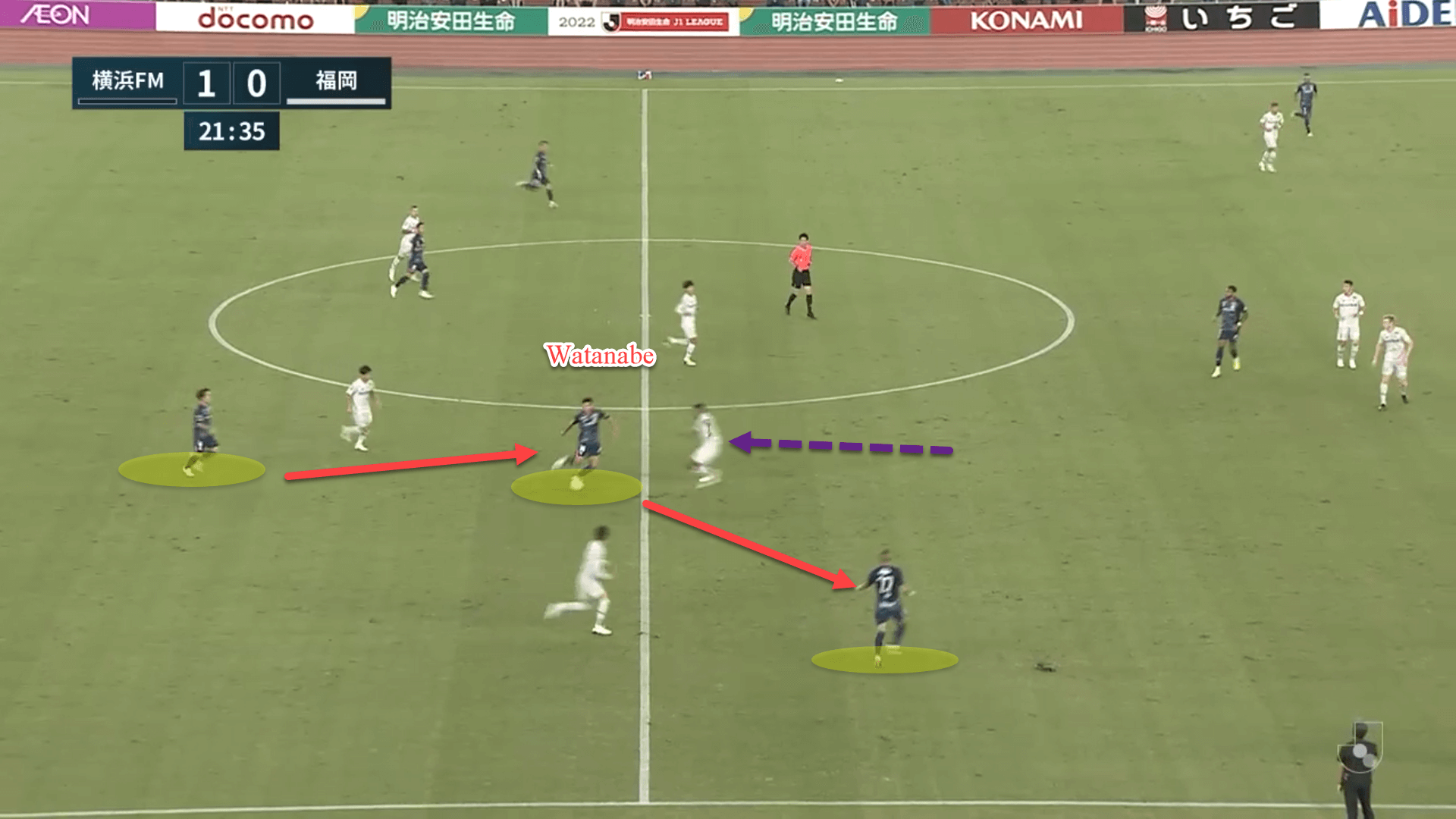
Here, Kota Watanabe has received the ball from the centre-backs, orienting his body to take it on the half-turn. This narrows the opponent’s press, allowing him to slide it in behind to the right-back.
Body positioning is of utmost importance for any midfielders and Yokohama FM’s pivot players almost always have this down to a tee which allows them to choose the right option to either bounce the ball back to the centre-backs or else quickly flick it in behind an on-rushing marker to move the ball into higher areas.
Regardless, as spoken about, there are times when simply dropping to a certain area of the pitch to drag a marker out of position is even more devastating.
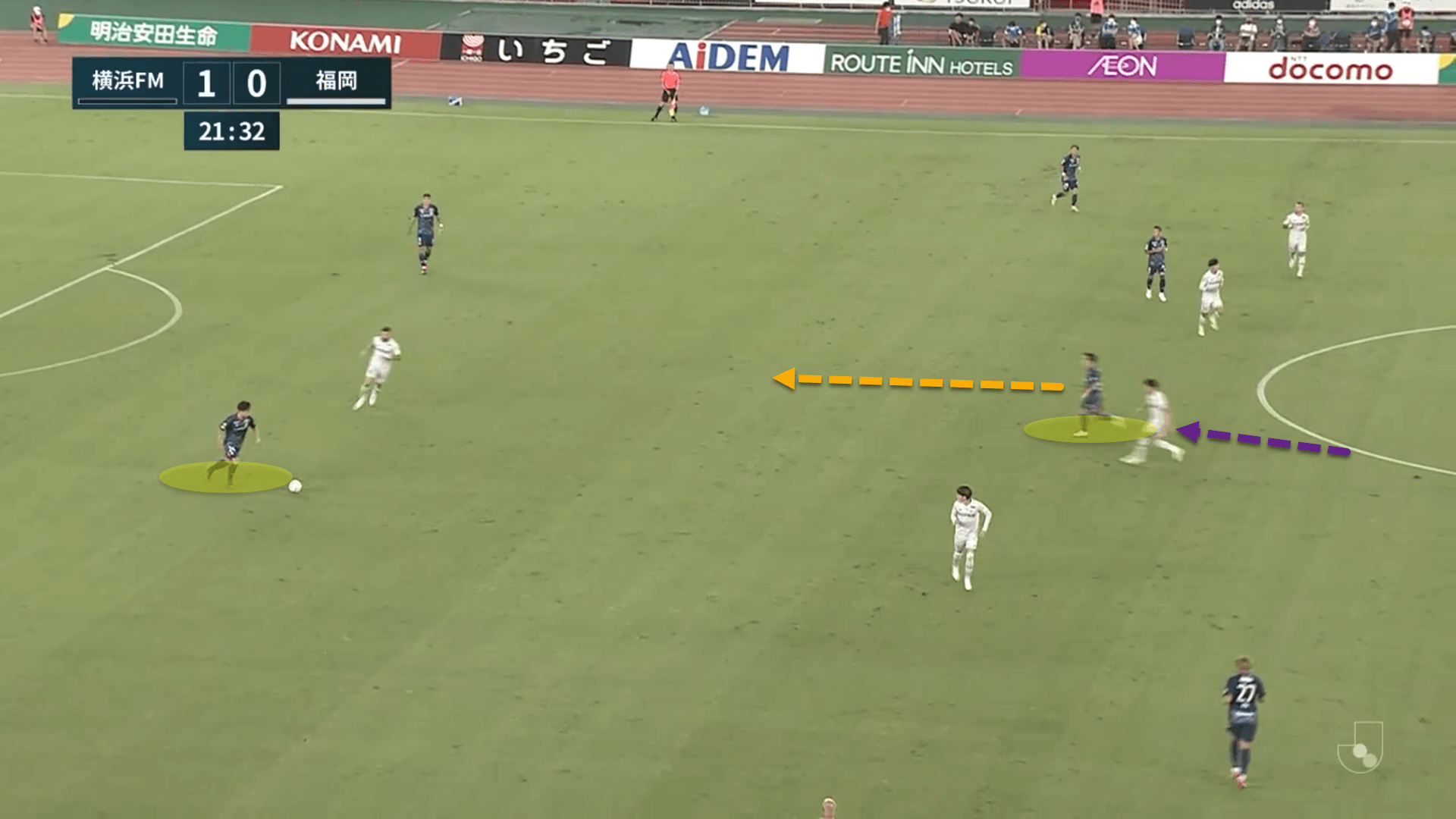
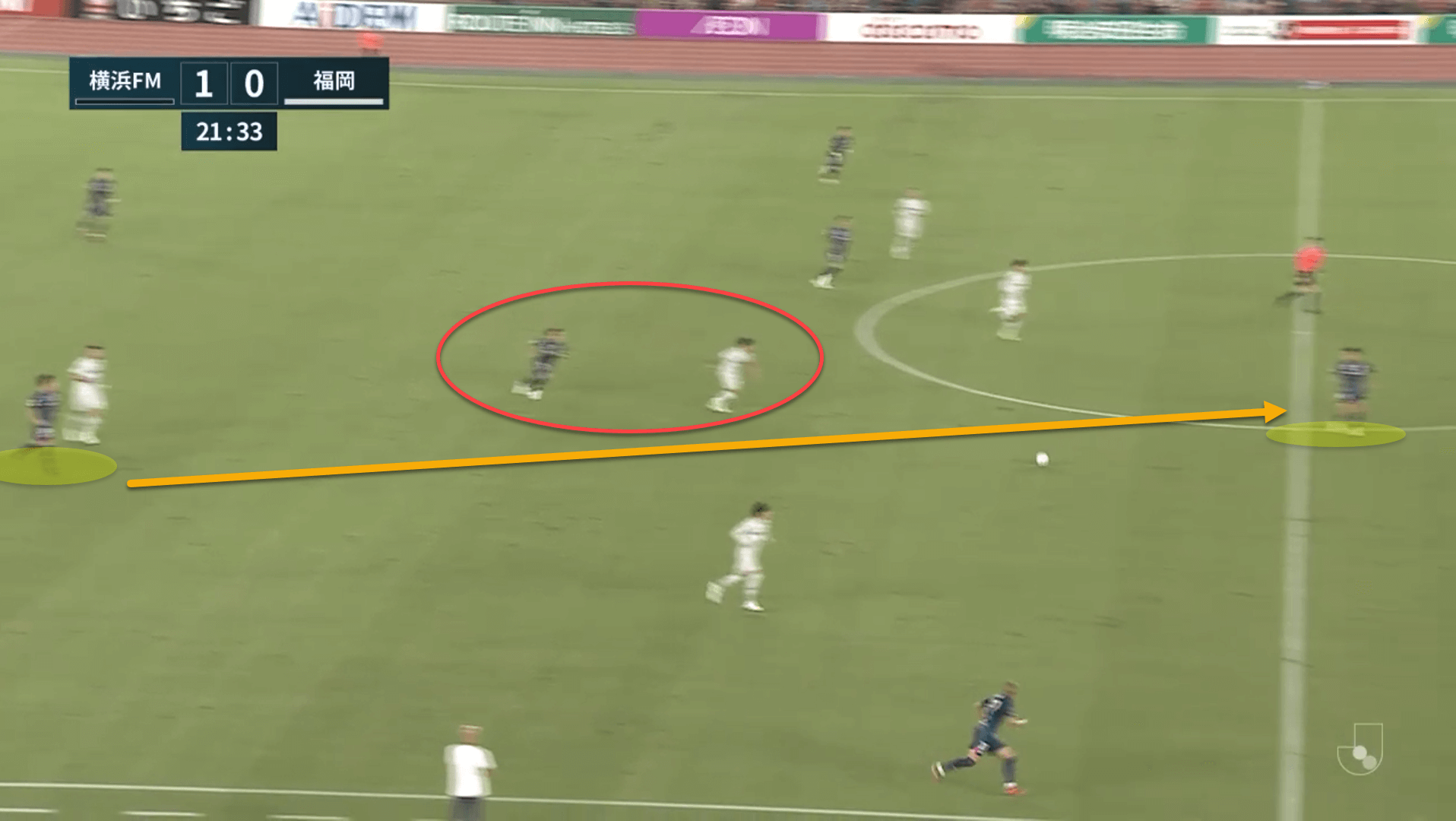
These two images are perfect examples of Yokohama FM being able to completely bypass the double-pivot to play between the lines to the attacking midfielder simply through their midfielder’s movement.
One half of the double-pivot drops short, causing the defender to track him into no man’s land. This opens up a direct passing lane between the centre-back and the number ‘10’, allowing for clean and easy ball progression into the opposition’s half from the build-up phase. The attacker has already positioned his body in a manner to take the ball forward with ease.
There is even still a tinge of Postecoglou’s methods in the side. Often, one of the fullbacks will move centrally, inverting behind the opponent’s first line of pressure to receive the ball, acting as yet another option for the centre-backs to play to in the pivot space.
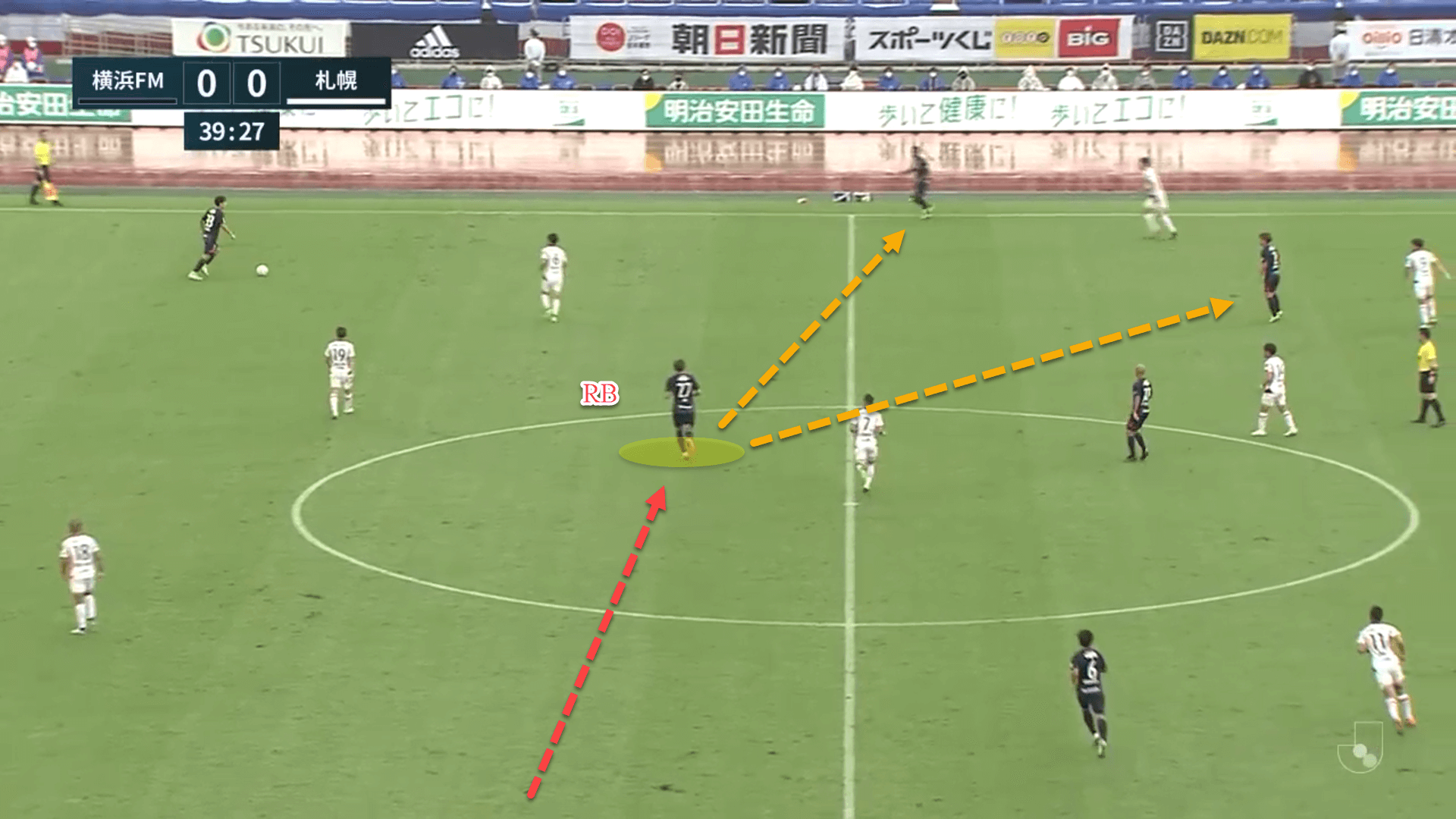
However, it’s not always smooth sailing for Muscat’s men. The soon-to-be champions have struggled against teams that are very aggressive with their pressing.
Again, Yokohama FM are always looking to play out from goal-kicks by using the double-pivot outside the penalty area. If these passing lanes are not available, the players are forced to go wide to the fullbacks which is where the struggle begins.
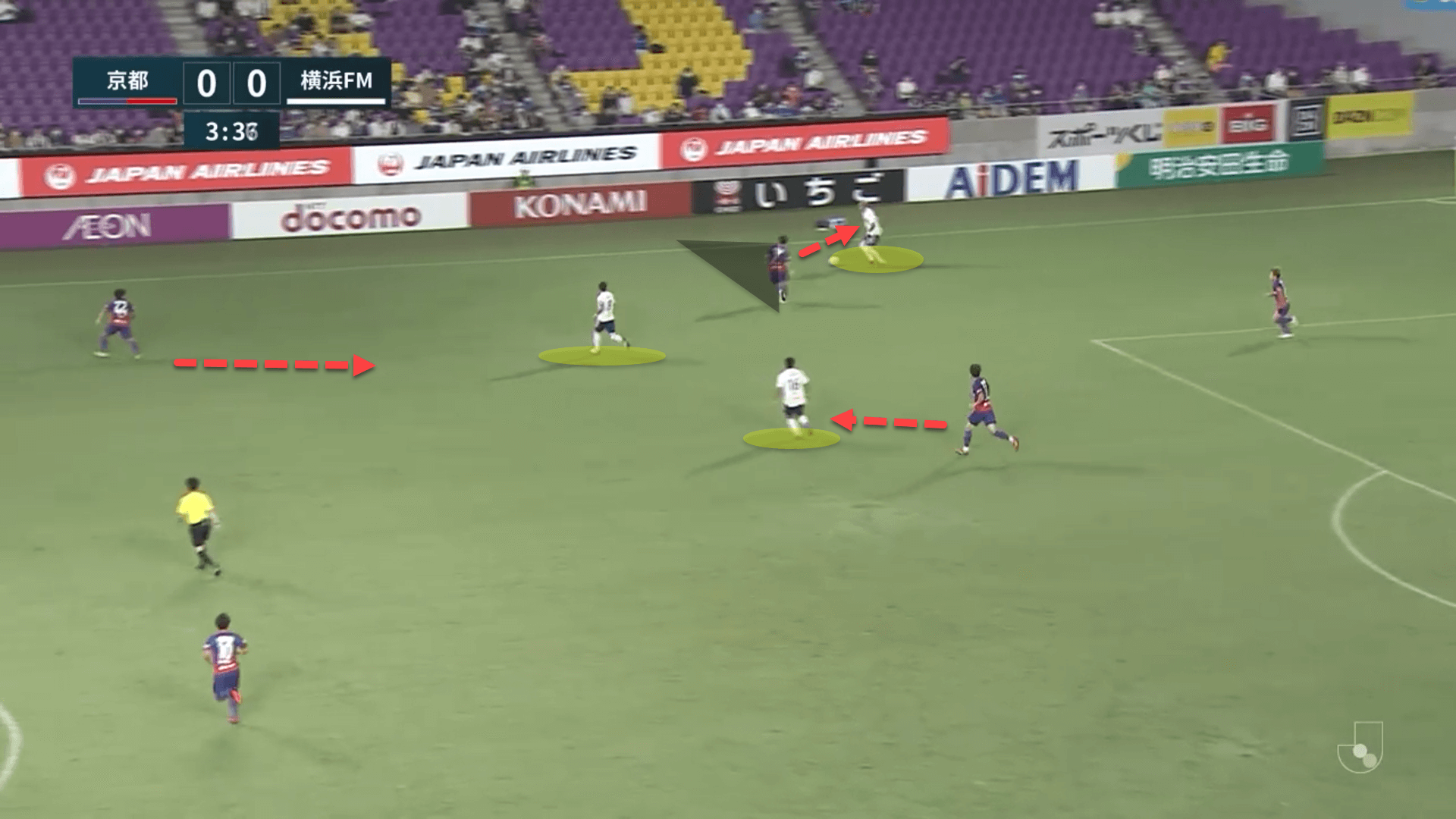
Here, the opposition have successfully cut off any progressive options into Yokohama F. Marinos’ midfielders. As a result, Muscat’s team had to play to the right-back in a low position on the flanks.
The issue for the J1 League leaders is that, when these situations arise, more often than not, they lose possession of the ball because the fullback is unable to reach the winger on his side due to their high positioning.
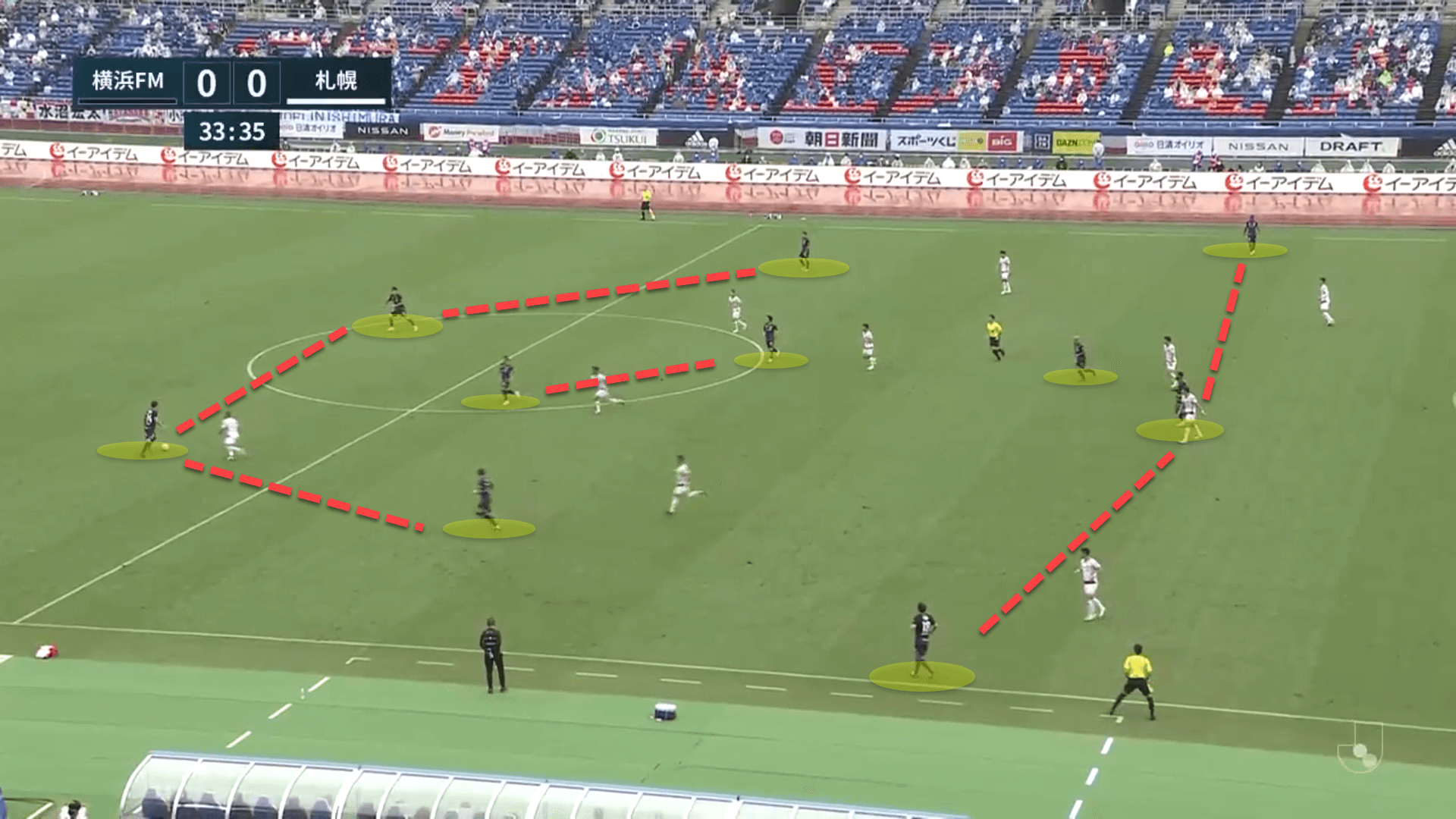
In this image, the team’s entire shape can be seen which is a basic 4-2-3-1, or a 4-2-1-3 with high wingers. The wingers are always very advanced, positioning themselves on the outside of the opponent’s fullbacks to pin them.
However, this means that the passing lane from their own fullbacks and wingers is a difficult one to reach due to the distance between them which causes issues when the central areas are cut off.
The art of deception
In the final third, once Yokohama FM have progressed through the opponent’s high and mid-level block, the players create wide overloads on the flanks in order to get the ball into the box to create goalscoring opportunities.
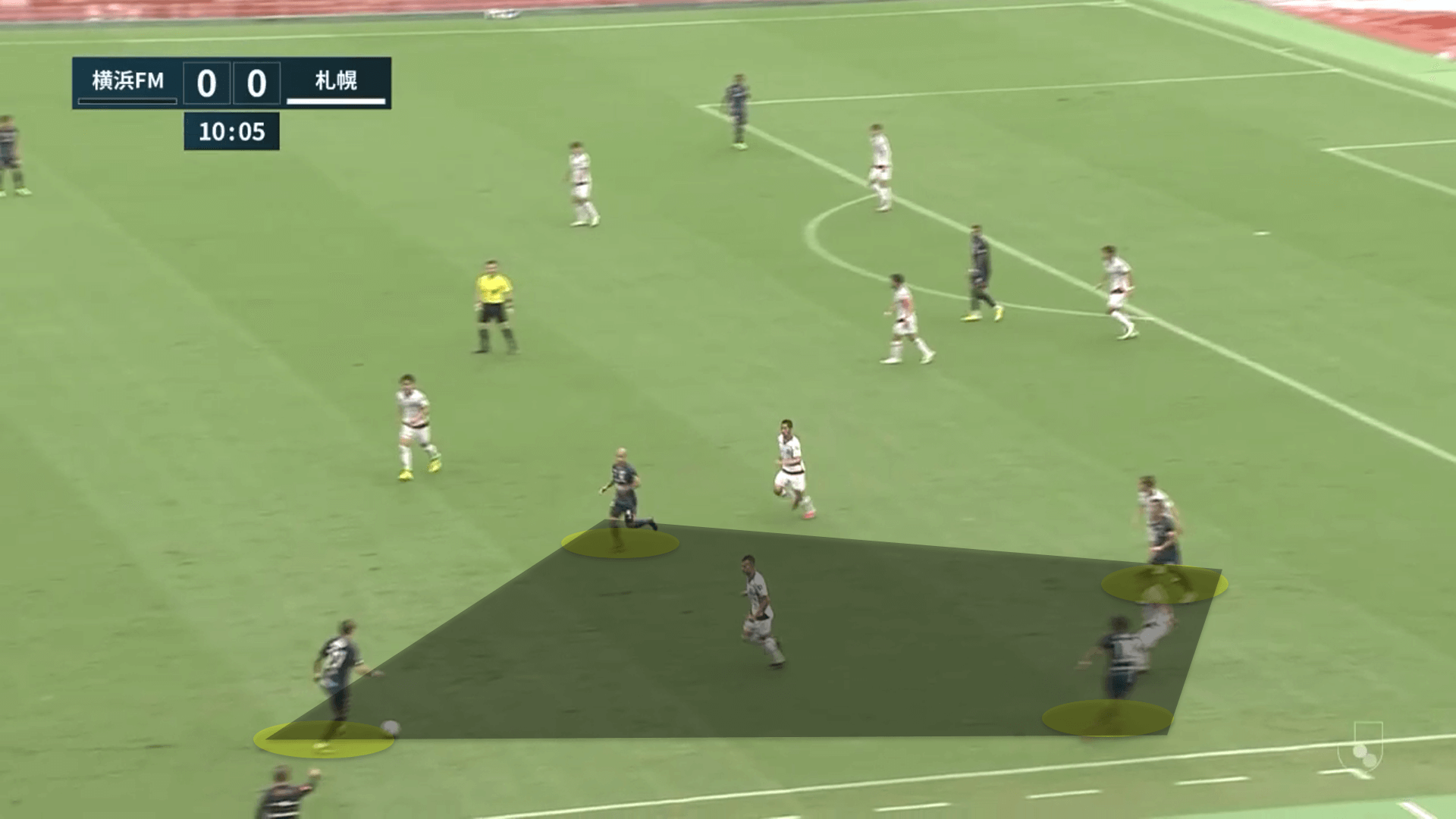
During wide overloads, teams use numerical superiority to get a free man on the ball in order to put a cross into the penalty area. They can be used in several different ways though.
Sometimes, teams will use the overload to play to a runner in behind which would allow them to cross the ball closer to the by-line. Muscat prefers his players to use the overloads to get free men in the halfspaces or deeper crossing positions out wide in order to put in inswinging deliveries, also utilising decoy runs to do so.
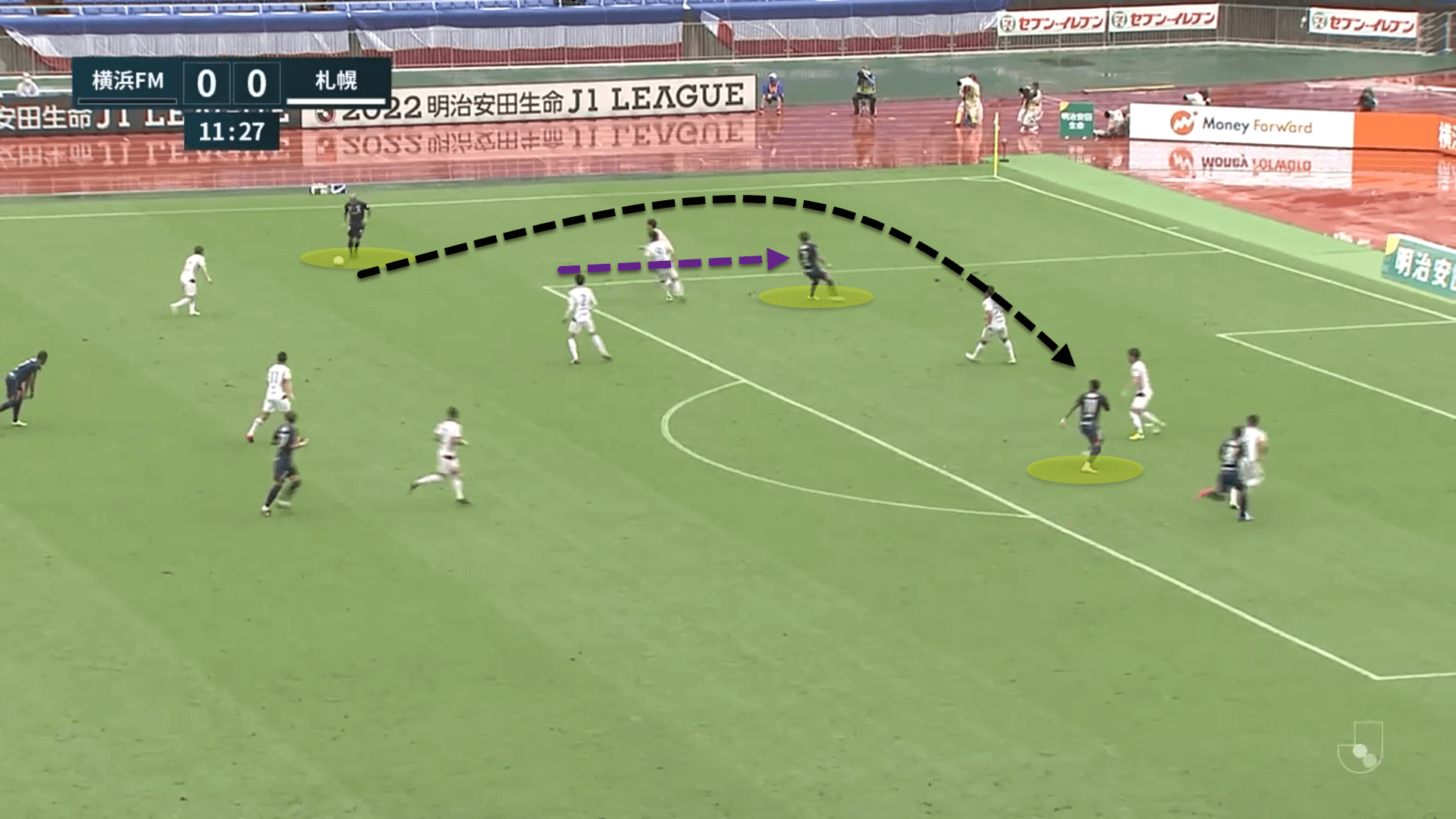
For instance, here, the Yokohama fullback has made a run beyond the backline, bringing his opposite number deeper with him. This leaves the wide player free to whip an inswinging ball into the box towards the forwards.
Most of Yokohama FM’s penalty area entries come from these positions:
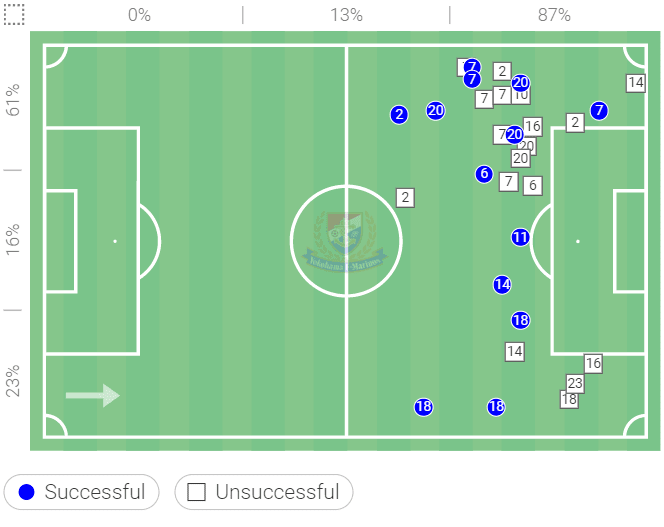
This data viz shows all 31 of the team’s penalty area entries from a recent league outing against Consadole Sapporo. Primarily coming from the left flank, the entries are mainly in the left halfspace and from wider positions.
Nonetheless, where possible, Yokohama will attempt to create goalscoring opportunities through the central areas in Zone 14 which is where the most dangerous chances can come from.
What makes Marinos so special to watch in these positions is how the players use excellent body orientation and third-man runs to play the ball through a low block in such a congested area.
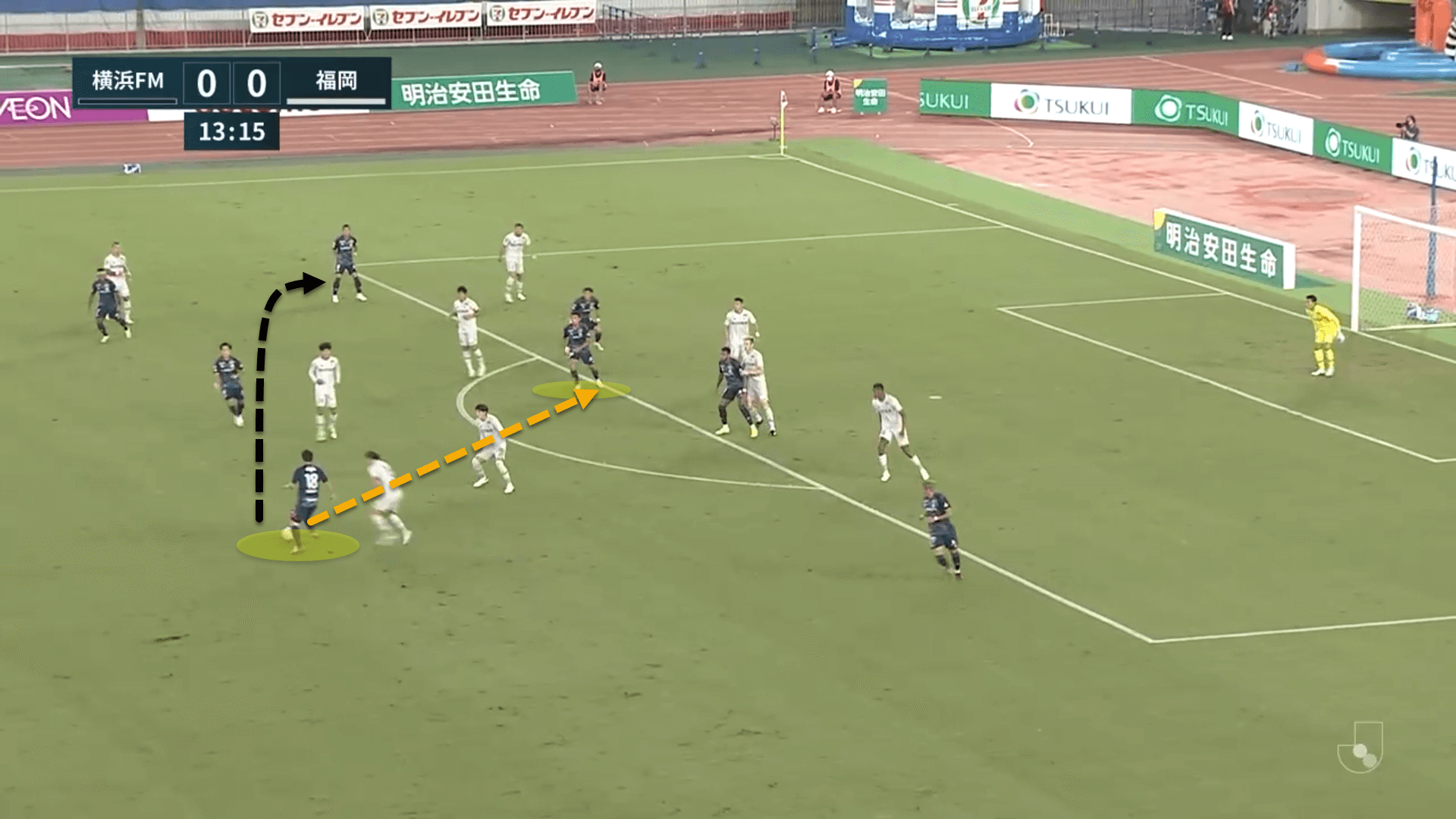
A perfect example of this came in the side’s 1-0 victory over Avispa Fukuoka a few weeks back. Here, the right-winger Kota Mizunuma is shaping his body to switch the play out to the left, having cut inside from the right side, tricking the opponents into a false sense of security.
Instead, he quickly taps the ball with a beautifully weighted pass into the foot of Takuma Nishimura.
Once again, Nishimura looks ready to trap the ball with his back foot which would give the defenders a chance to close him down to get rid of the danger. However, the number ‘10’ has other ideas. Turning his body to the side, looking ready to take a touch, Nishimura plays a first-time ball into striker Anderson Lopes who places it home to score the winner.
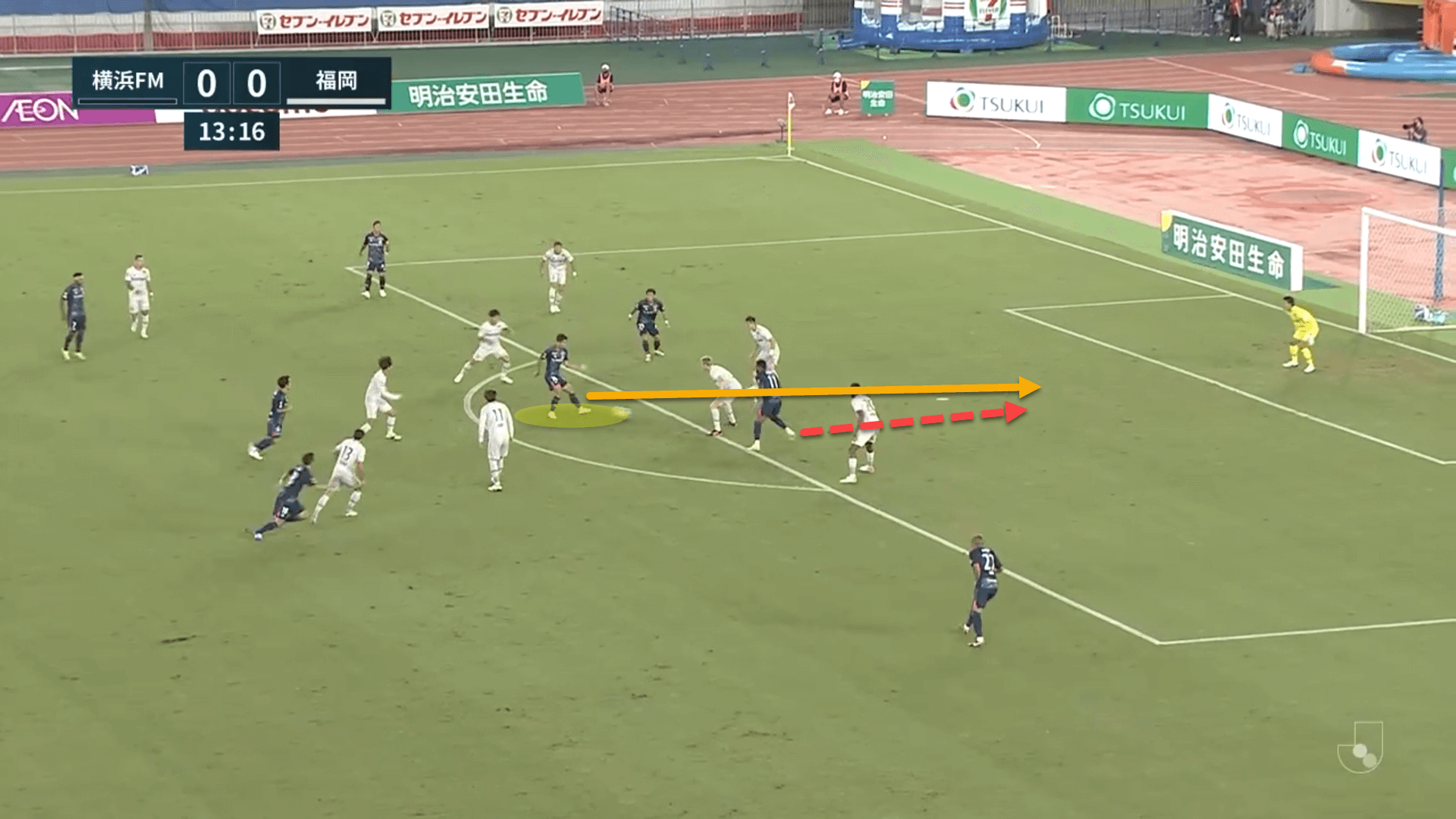
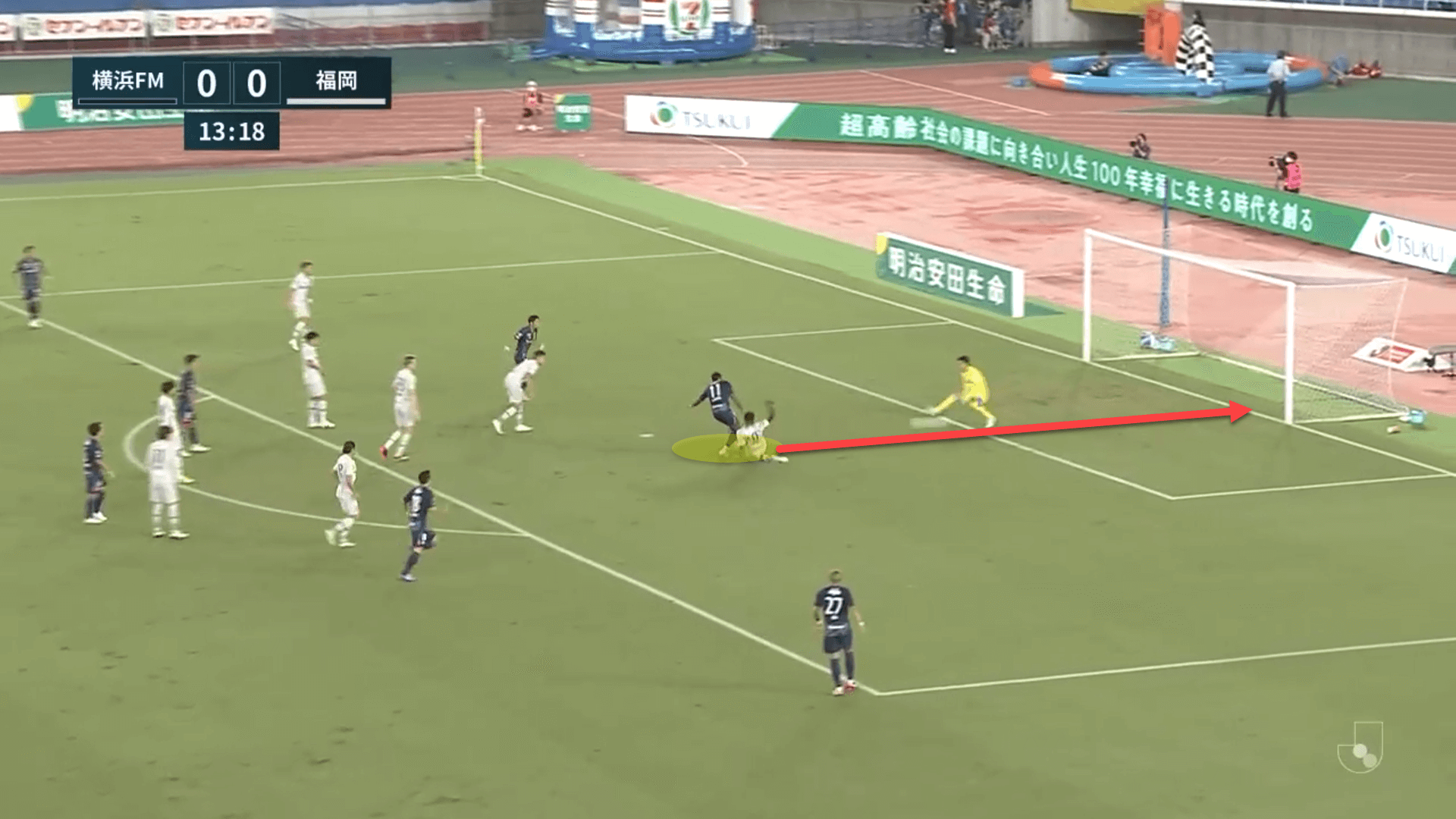
Deception is a vital tool in any player’s arsenal that many haven’t quite mastered. unless you play for Kevin Muscat, that is. Then, it’s pretty common.
Pressing and low block defending
During the defensive phases, Muscat wants his players to be very proactive, constantly hunting the ball down in order to win it as high up the pitch as possible.
Yokohama FM boast the second-lowest Passes allowed Per Defensive Action (PPDA) in the J1 League this season with 8.32 and the highest challenge intensity with 7. The latter metric measures how many defensive actions a team make per minute of opposition possession. Combined, both give a great quantification of how high a team presses.
Unlike their intricate offensive system, Marinos are not inventive out of possession, but are still effective, nonetheless.
The job of the centre-forward is the most important. The frontman is tasked with pressing the opponent’s centre-backs, forcing them wider by cutting off access to one.
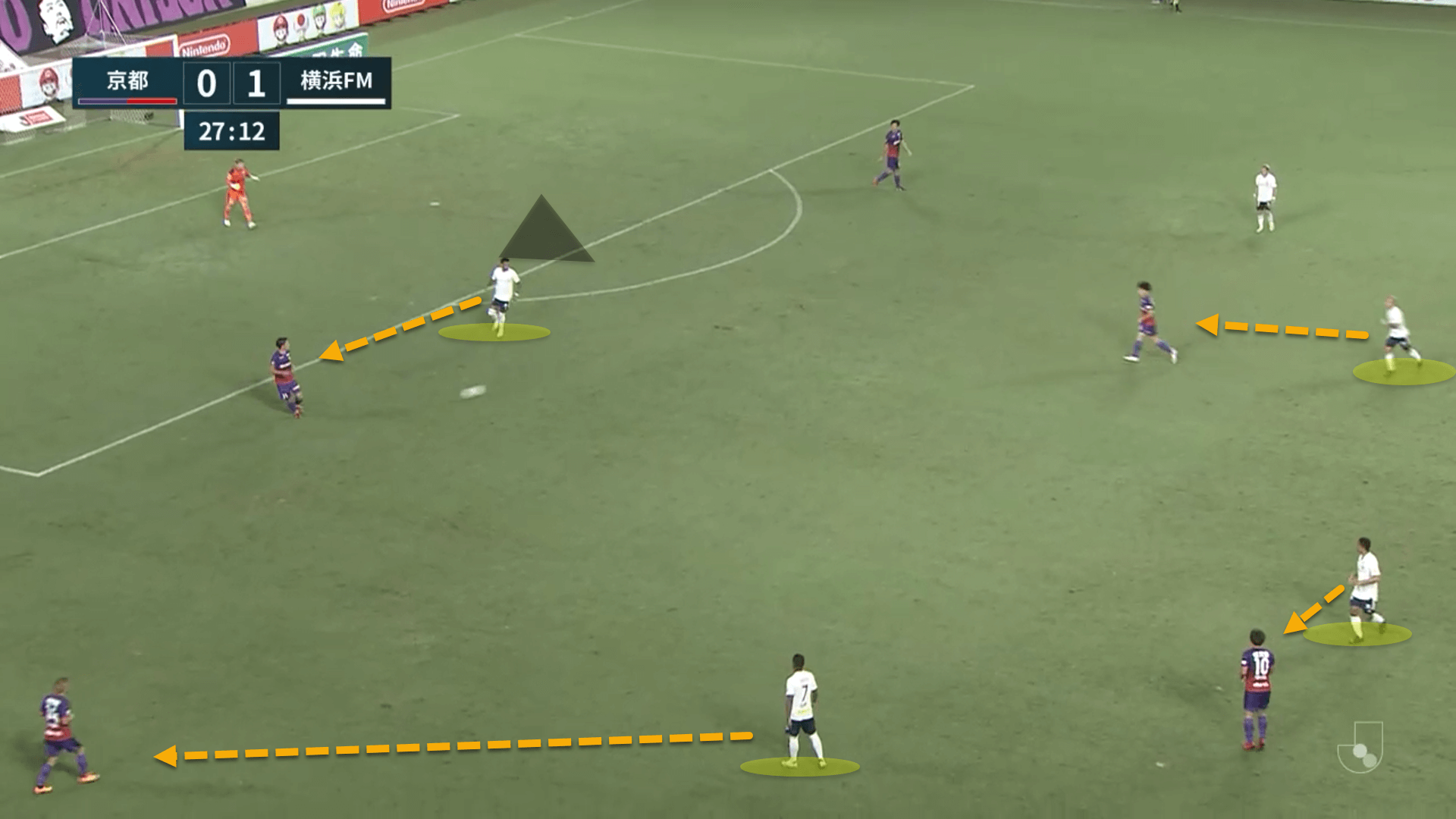
From there, as shown in the example above, the team’s block drops to one side and the players are tasked with going man-to-man against their opposite numbers which is where they can win the ball back, using the touchline as an extra defender since the attacking side will have limited passing options.
This can be seen from the team’s total defensive duels from their recent league game against Avispa Fukuoka.
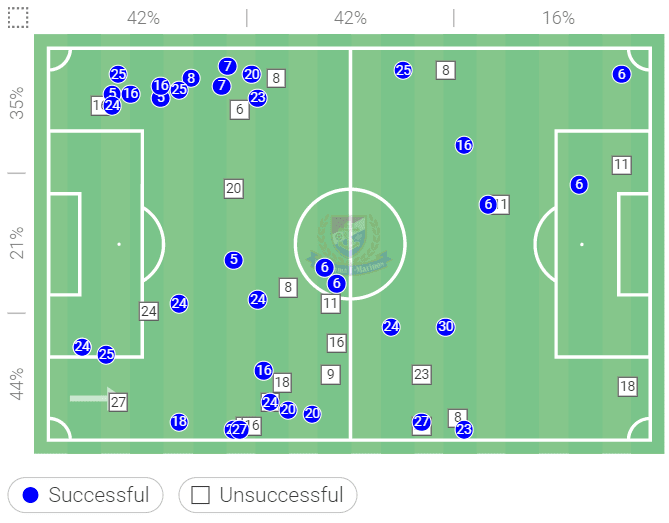
Of 57 defensive duels, 79 percent were in the wide areas and halfspaces as Yokohama FM won 65.63 percent of their battles.
Once the opposition bypass Yokohama’s pressing, the team’s defensive block drops deeper and deeper, looking to consolidate space between the lines and the distance from the backline to the goalkeeper to prevent through balls over the top.
Nevertheless, Muscat likes to instruct his men to stay very compact horizontally too, dropping to the ball-side, meaning the defensive block covers very little of the pitch overall.
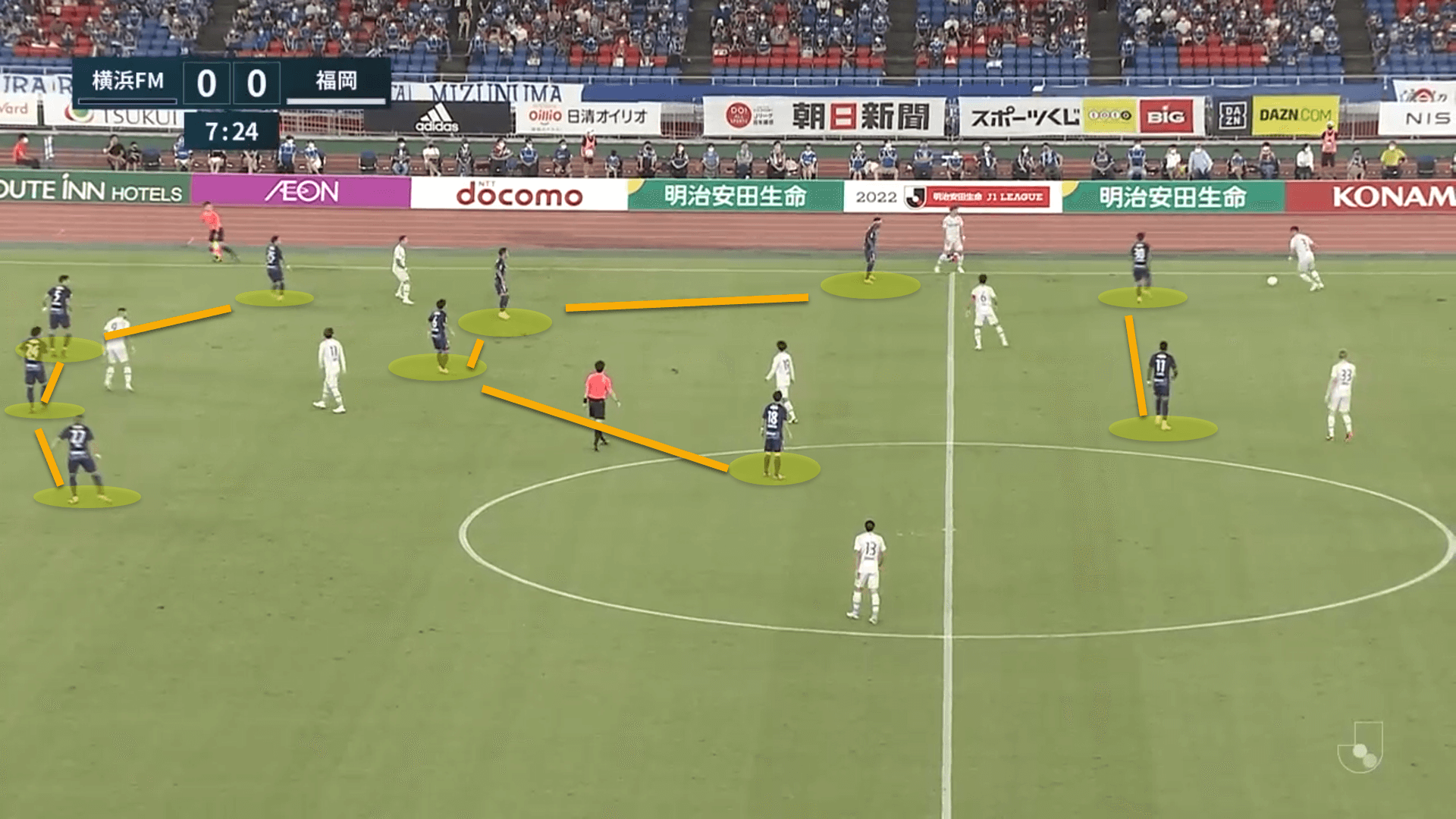
The benefit of such a compact defensive structure is that it’s really difficult for the attacking side to play through as the lines are so congested.
However, as many opponents have looked to exploit, it leaves quite a lot of space on the flanks for a quick switch of play. Once the ball is swapped to the far side, the ball-far wide player can attempt to beat Marinos’ fullback in a 1v1 duel as Muscat’s team try to rapidly recover their shape on the far side.
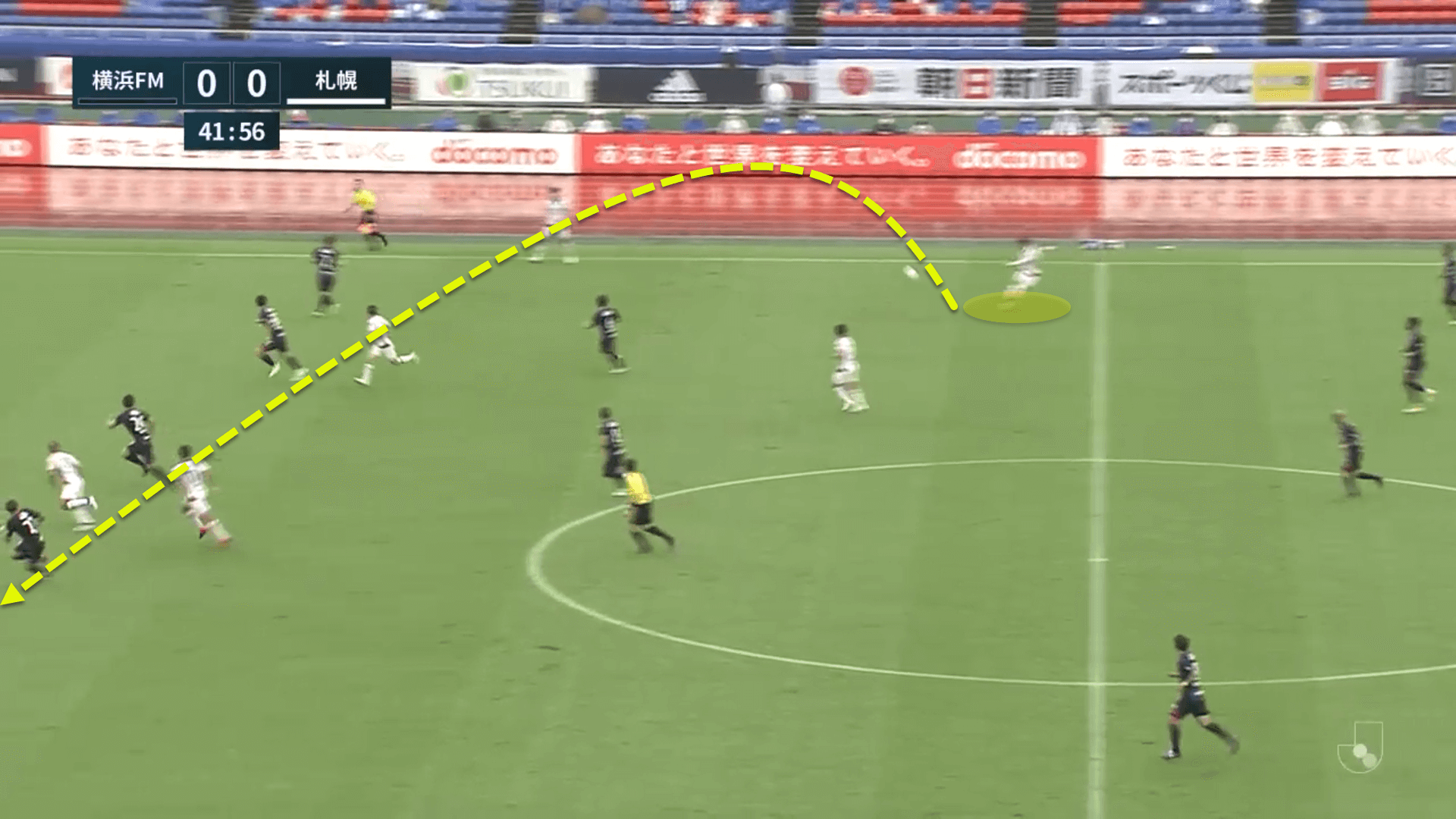
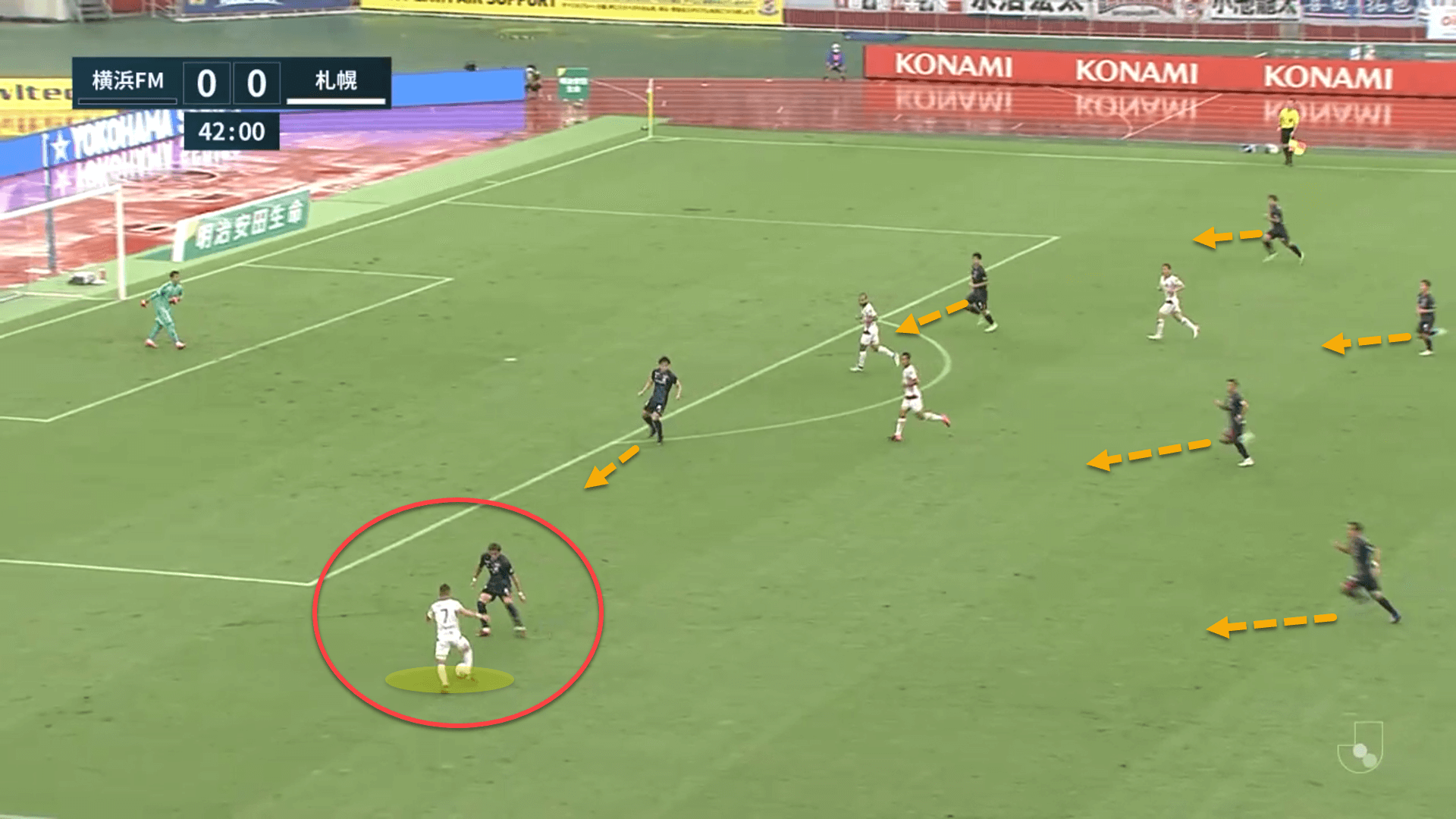
The Japanese side’s defensive record isn’t too great either. The team are conceding an average of 1.18 xG per game this season and allowing 1.08 goals to trickle in per game too. This is certainly an area that can be improved upon by Muscat.
It sounds rather counterproductive but perhaps a more dispersed defensive block would reap better results.
Conclusion
Yokohama F. Marinos are undoubtedly one of the most tactically intriguing teams in Asia this season under Muscat and have been ever since Postecoglou’s days for that matter.
The side have a distinct style of play with players able to carry out the game plan down to a tee as the football is truly sumptuous to watch at times.
There are areas of improvement needed, especially defensively. No team is perfect. However, from watching their most recent matches, it’s no wonder that Muscat’s men are on the verge of their second J1 League title in three years.






Comments